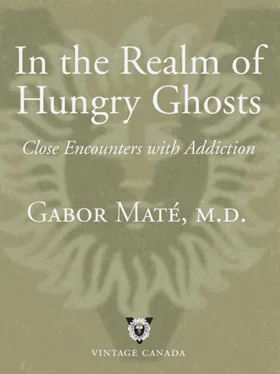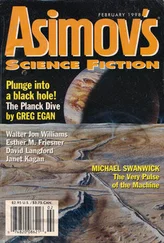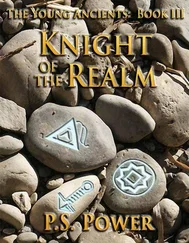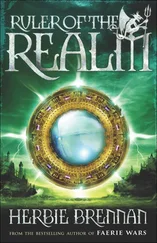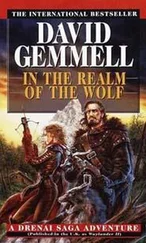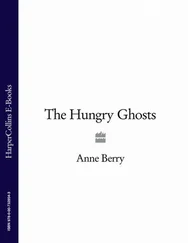16. N.S. Miller and M.S. Gold, “A Hypothesis for a Common Neurochemical Basis for Alcohol and Drug Disorders,” Psychiatric Clinics of North America 169(1) (1993): 105–17.
CHAPTER 15 COCAINE, DOPAMINE AND CANDY BARS
1. C.E. Moan and R.G. Heath, “Septal Stimulation for the Initiation of Heterosexual Activity in a Homosexual Male,” Journal of Behavior Therapy and Experimental Psychiatry 3 (1972): 23–30.
2. N.D. Volkow et al., “Role of Dopamine in Drug Reinforcement and Addiction in Humans: Results from Imaging Studies,” Behavioral Pharmacology 13 (2002): 355–66.
3. N.D. Volkow et al., “Low Level of Brain Dopamine D2 Receptors in Methamphetamine Abusers: Association with Metabolism in the Orbitofrontal Cortex,” American Journal of Psychiatry 158(12) (December 2001): 2015–21.
4. Eliot L. Gardner, “Brain-Reward Mechanisms,” chap. 5, section II in Substance Abuse: A Comprehensive Textbook, by Joyce H. Lowinson et al. (Philadelphia: Lippincott, Williams & Wilkins, 2005), 71.
5. D.W. Self, “Regulation of Drug-Taking and-Seeking Behaviors by Neuroadaptations in the Mesolimbic Dopamine System,” Neuropharmacology 47 (2005): 252–55.
6. J. Panksepp et al., “The Role of Brain Emotional Systems in Addictions: A Neuro-Evolutionary Perspective and New ‘Self-Report’ Animal Model,” Addiction 97 (2002): 459–69.
CHAPTER 16 LIKE A CHILD NOT RELEASED
1. N.D. Volkow and T.-K. Li, “Drug Addiction: The Neurobiology of Behaviour Gone Awry,” Neuroscience 5 (December 2004): 963–70.
2. Joseph LeDoux, The Emotional Brain: The Mysterious Underpinnings of Emotional Life (New York: Simon & Schuster, 1996), 165.
3. Jeffrey M. Schwartz with Sharon Begley, The Mind and the Brain: Neuroplasticity and the Power of Mental Force (New York: HarperCollins, 2002), 312.
4. S. Pellis et al., “The Role of the Cortex in Play Fighting by Rats: Developmental and Evolutionary Implications,” Brain, Behavior and Evolution 39 (1992): 270–84, quoted in Gordon M. Burghardt, “Play: Attributes and Neural Substrates,” in Handbook of Behavioral Neurobiology, vol, 13, ed. E. Blass (New York: Plenum Publishers, 2001), 388.
5. E.D. London et al., “Orbitofrontal Cortex and Human Drug Abuse: Functional Imaging,” Cerebral Cortex 10(3) (March 2000): 334–42; see also R.Z. Goldstein and N.D. Volkow, “Drug Addiction and Its Underlying Neurobiological Basis: Neuroimaging Evidence for the Involvement of the Frontal Cortex,” American Journal of Psychiatry 159 (2002): 1642–52.
6. A.N. Schore, “Structure-Function Relationships of the Orbitofrontal Cortex,” chap. 4 in Affect Regulation and the Origin of the Self (Hillsdale, NJ: Lawrence Erlbaum Associates, 1994), 34–61.
7. Goldstein and Volkow, “Drug Addiction and Its Underlying Neurobiological Basis.”
8. London et al., “Orbitofrontal Cortex.”
9. G. Dom et al., “Substance Use Disorders and the Orbitofrontal Cortex: Systematic Review of Behavioural Decision-Making and Neuroimaging Studies,” The British Journal of Psychiatry 187 (2005): 209–20.
10. London et al., “Orbitofrontal Cortex.”
11. Ibid.
12. Goldstein and Volkow, “Drug Addiction and Its Underlying Neurobiological Basis.”
13. N.D. Volkow et al., “Low Level of Brain Dopamine D2 Receptors in Methamphetamine Abusers: Association with Metabolism in the Orbitofrontal Cortex,” American Journal of Psychiatry 158(12) (December 2001): 2015–21.
14. Goldstein and Volkow, “Drug Addiction and Its Underlying Neurobiological Basis.”
15. G. Bartzokis et al., “ Brain Maturation May Be Arrested in Chronic Cocaine Addicts, ” Biological Psychiatry 51(8) (April 2002): 605–11; Goldstein and Volkow, “Drug Addiction and Its Underlying Neurobiological Basis.”
CHAPTER 17 THEIR BRAINS NEVER HAD A CHANCE
1. To name four seminal works: Affect Regulation and the Origin of the Self: The Neurobiology of Emotional Development , by Allan Schore; Affective Neuroscience: The Foundations of Human and Animal Emotions , by Jaak Panksepp; The Developing Mind: Toward a Neurobiology of Interpersonal Experience , by Daniel Siegel, and Human Behavior and the Developing Brain , edited by Kurt W. Dawson and Geraldine Fischer.
2. Antonio Damasio, Descartes’ Error: Emotion, Reason, and the Human Brain (New York: G.P. Putnam & Sons, 1994), 255.
3. V.J. Felitti, “Ursprünge des Suchtverhaltens—Evidenzen aus einer Studie zu belaststenden Kindheitserfahrungen” (“The Origins of Addiction: Evidence from the Adverse Childhood Experiences Study”), Praxis der Kinderpsychologie under Kinderpsychiatrie 52 (2003): 547–59.
4. B. Perry and R. Pollard, “Homeostasis, Stress, Trauma and Adaptation: A Neurodevelopmental View of Childhood Trauma,” Child and Adolescent Clinics of North America 7(1) (January 1998): 33–51. Citing data from R. Shore, Rethinking the Brain: New Insights into Early Development (New York: Families and Work Institute, 1997).
5. Kurt W. Dawson and Geraldine Fischer, eds., Human Behavior and the Developing Brain (New York: The Guildford Press, 1994), 9.
6. B.D. Perry et al., “Childhood Trauma, the Neurobiology of Adaptation, and ‘Use-dependent’ Development of the Brain: How ‘States’ Become ‘Traits,’” Infant Mental Health Journal 16(4) (1995): 271–91.
7. R. Kotulak, Inside the Brain: Revolutionary Discoveries of How the Mind Works (Kansas City: Andrews and McMeel, 1996).
8. D. Siegel, The Developing Mind: Toward a Neurobiology of Interpersonal Experience (New York: The Guildford Press, 1999), 85.
9. Ibid, 67 and 85.
10. Dawson and Fischer, Human Behavior, 367.
11. M.R. Gunnar and B. Donzella, “Social Regulation of the Cortisol Levels in Early Human Development,” Psychoneuroendocrinology 27(1–2) (January-February 2002): 199–220.
12. R. Joseph, “Environmental Influences on Neural Plasticity, the Limbic System, Emotional Development and Attachment: A Review,” Child Psychiatry and Human Development 29(3) (Spring 1999): 189–208.
CHAPTER 18 TRAUMA, STRESS AND THE BIOLOGY OF ADDICTION
1. A.N. Schore, Affect Regulation and the Origin of the Self (Hillsdale, NJ: Lawrence Erlbaum Associates, 1994), 142.
2. S.L. Dubovsky, Mind Body Deceptions: The Psychosomatics of Everyday Life (New York: W. W. Norton, 1997), 193.
3. G. Blanc et al., “Response to Stress of Mesocortico-Frontal Dopaminergic Neurons in Rats after Long-Term Isolation,” Nature 284 (20 March 1980): 265–67.
4. M.J. Meaney et al., “Environmental Regulation of the Development of Mesolimbic Dopamine Systems: A Neurobiological Mechanism for Vulnerability to Drug Abuse?” Psychoneuroendocrinology 27 (2002): 127–38.
5. Harold H. Gordon, “Early Environmental Stress and Biological Vulnerability to Drug Abuse,” Psychoneuroendocrinology 27 (2002): 115–26.
6. C. Caldji et al., “Maternal Care During Infancy Regulates the Development of Neural Systems Mediating the Expression of Fearfulness in the Rat,” Neurobiology 95(9) (28 April 1998): 5335–40.
7. J.D. Higley and M. Linnoila, “Low Central Nervous System Serotonergic Activity Is Traitlike and Correlates with Impulsive Behavior,” Annals of the New York Academy of Science 836 (29 December 1997): 39.
8. A.S. Clarke et al., “Rearing Experience and Biogenic Amine Activity in Infant Rhesus Monkeys,” Biological Psychiatry 40(5) (1 September 1996): 338–52; see also J.D. Higley et al., “Nonhuman Primate Model of Alcohol Abuse: Effects of Early Experience, Personality, and Stress on Alcohol Consumption,” Proceedings of the National Academy of Sciences USA 88 (August 1991): 7261–65.
Читать дальше
